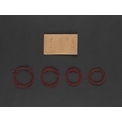
- Four red strings
These strings were presented as a gift to Tsar Teh-yun from Shen Caonong in the 1940s. At that time, nobody was making qin strings. So it is estimated that the latest timing of production of the strings was late Qing Dynasty or the early years of the Republic of China.
The exhibit comprises only the first to the fourth strings. Three of them are brand new. One has been used, but probably only on a trial basis. They are formerly in the collection of Tsar Teh-yun.
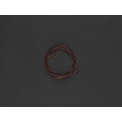
- Old red string
The colour of the exhibit has turned dark. This is a result of the left hand running over the string. A bright red colour is retained where the string has not been touched by the hand. There are obvious signs that the section next to the knot at the head has been plucked, showing that the string has been used for a period of time. This serves as evidence that red strings were used by qin players in the past. This string is formerly in the collection of Zheng Minzhong and its production date is estimated to be around late Qing Dynasty or the early years of the Republic of China.
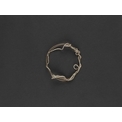
- Ultra thick old string
It is said that Guan Pinghu preferred ultra thick strings. His strings were all made to order. This was not unlikely, for at the back of the string wrapping of Fang Yuting Cooperative for the Production of Strings, there was the claim that “silk strings of all thickness are produced”. Zheng Minzhong was a student of Guan Pinghu, and his habit of using strings may also have been influenced by his teacher.
The diameter of this string is longer than the first string of jiazhong Taigu String, so the specification is different from that of ordinary strings. This string is formerly in the collection of Zheng Minzhong and its production date is unknown.
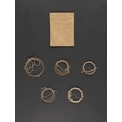
- Strings used by Tsar Teh-yun
In the past, qin strings were in short supply. Strings, be they old or new, were very much treasured by qin players. They would usually keep used strings for replacing broken strings in future or for presentation to students as gifts. Tsar Teh-yun was very conscientious and attentive to details. She would neatly tie and wrap all used strings, indicating when and from which instrument they were removed or which set of strings they replaced. Her meticulous efforts can be seen from the wrapping of this exhibit as well as the exhibits, namely “guqin string wrapping converted from a guzheng string wrapping” and the wrapping of the “four red strings”, both of which are formerly in the collection of Tsar Teh-yun.
This photo shows a full set of strings which also is formerly in the collection of Tsar Teh-yun. The first to the fourth strings are separately tied, while the fifth to the seventh strings are tied together. The production period of these strings is estimated to be around 1970s-1980s.
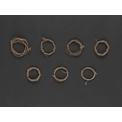
- Strings used by Wang Di
Wang Di, a student of Guan Pinghu, kept all her used strings. She had an abundance of them. Affected by the earthquake at Tangshan in 1976, people in Beijing stayed outdoors overnight. Wang Di had so many used strings that she put up her tent at that time with used strings.
This photo shows a complete set of strings kept by Wang Di and presented to Wong Shu-chee for studying. The production date of this set of strings is unknown.
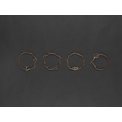
- Strings used by Zheng Minzhong
Silk strings are unstable in their quality. Qin players in the past had their own ways to improve the quality of the strings. Some would apply paraffin, cream or various types of glue to the strings. Some would even rub their hair with both hands every time before playing the qin so as to lubricate the strings with the oil in their hair.
The exhibit comprises the first to the fourth strings. The strings are shiny, a sign that they have been specially treated to reduce buzzing noises. The production date of the strings is unknown.
